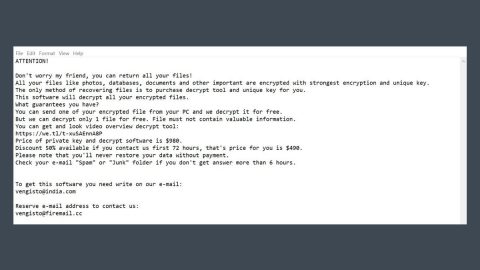What is Freshdesk ransomware? And how does it work?
Freshdesk ransomware is a highly malicious program that encrypts files. Despite its name, Freshdesk is not in any way, associated with the legitimate Freshdesk help desk ticketing system maintained by Freshdesk Inc. It had gotten its name since the cyber criminals who developed this malware uses the name “Freshdesk” on its ransom note delivered to its victims. This malware is designed to encode important data on the compromised computer and displays a message that includes the statement “Help Desk software by Freshdesk”. During its encryption attack, it uses both the AES and RSA encryption algorithm in encoding your files and appends the .www file extension on the targeted files. After that, it drops its ransom note under an html file named restore_files.html, which is intended to look like a professional access panel to decryption services available to users infected with the Freshdesk ransomware and contains the following message:
“Your files are Encrypted!
For data recovery needs decryptor.
To buy the decryptor, you must pay the cost of: 0.5 Bitcoin
Free decryption as guarantee.
Before paying you can send us 1 file for free decryption.
To send a message or file use this form:
Message or File
[TEXT BOX FOR EMAIL ADDRESS]
[TEXT BOX FOR SUBJECT LINE]
[TEXT BOX FOR MESSAGE]
Help Desk software by
Freshdesk
Privacy Policy”
How does Freshdesk ransomware spread online to your computer?
Freshdesk, like most ransomware infections, arrives on a computer’s system using a malicious file which is usually a Microsoft document with macro-enabled feature that is distributed through spam emails. These spam emails are disguised as an invoice, receipts, or any official documents to trick users into opening and downloading them. Once you download and open the corrupted file, the macro-enabled document runs a command that establishes a connection to the ransomwware’s Command and Control server. From there, Freshdesk starts to launch its attack. That’s why it is important to be cautious and beware of catchy spam emails from unknown senders to prevent your computer from the likes of Freshdesk ransomware.
To terminate Freshdesk ransomware, follow the instructions below:
Step 1: Open Windows Task Manager by pressing Ctrl + Shift + Esc at the same time.

Step 2: Go to the Processes tab and look for any suspicious processes and then kill them.

Step 3: Open Control Panel by pressing the Windows key + R, then type in appwiz.cpl and then click OK or press Enter.

Step 4: Look for Freshdesk ransomware or any suspicious program and then Uninstall.

Step 5: Hold down Windows + E keys simultaneously to open File Explorer.
Step 6: Go to the directories listed below and delete everything in it. Or other directories you might have saved the file related to Freshdesk ransomware.
- %APPDATA%
- %USERPROFILE%\Downloads
- %USERPROFILE%\Desktop
- %TEMP%
Step 7: Look for the html file created by Freshdesk ransomware, restore_files.html.
Step 8: Empty the Recycle Bin.
Step 9: Try to recover your encrypted files.
Restoring your encrypted files using Windows’ Previous Versions feature will only be effective if the Freshdesk Ransomware hasn’t deleted the shadow copies of your files. But still, this is one of the best and free methods there is, so it’s definitely worth a shot.
To restore the encrypted file, right-click on it and select Properties, a new window will pop-up, then proceed to Previous Versions. It will load the file’s previous version before it was modified. After it loads, select any of the previous versions displayed on the list like the one in the illustration below. And then click the Restore button.

Step 10: After the system restore process, download SpyRemover Pro to remove any remaining files or residues of the Freshdesk Ransomware.
Follow the continued advanced steps below to ensure the removal of the Freshdesk ransomware:
Perform a full system scan using SpyRemover Pro.
- Turn on your computer. If it’s already on, you have to reboot
- After that, the BIOS screen will be displayed, but if Windows pops up instead, reboot your computer and try again. Once you’re on the BIOS screen, repeat pressing F8, by doing so the Advanced Option shows up.
- To navigate the Advanced Option use the arrow keys and select Safe Mode with Networking then hit
- Windows will now load the Safe Mode with Networking.
- Press and hold both R key and Windows key.
- If done correctly, the Windows Run Box will show up.
- Type in explorer http://www.fixmypcfree.com/install/spyremoverpro
A single space must be in between explorer and http. Click OK.
- A dialog box will be displayed by Internet Explorer. Click Run to begin downloading SpyRemover Pro. Installation will start automatically once download is done.
- Click OK to launch SpyRemover Pro.
- Run SpyRemover Pro and perform a full system scan.
- After all the infections are identified, click REMOVE ALL.
- Register SpyRemover Pro to protect your computer from future threats.
















